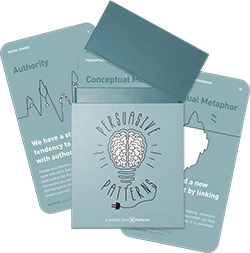Autonomy
Design Pattern
Problem summary
We strive to feel in control
Usage
- Use to increase experienced satisfaction of a product and user experience
- Use to make sure that your users don’t quit half way, as they might feel trapped in a tunnel
This card is part of the Persuasive Patterns printed card deck
The Persuasive Patterns Card Deck is a collection of 60 design patterns driven by psychology, presented in a manner easily referenced and used as a brainstorming tool.
Get your deck!Solution
- Speed up interactions. Speeding up interactions can help users feel more in control. Provide instant feedback as the user interacts with an interface to keep his or her momentum. Measures to speed up interactions could be to split up tasks and attention and reduce complexity.
- Allow customization. Adjusting our environment to our preferences, competence, and flow can provide a sense of freedom. Consider allowing customization of UI color, personal shortcuts, favorites, etc.
- Provide a sense of meaning. Meaning, competence, power to influence, and emotional engagement add to the feeling of autonomy and in turn satisfaction.
- Allow escape. Users might choose paths by mistake or regret embarking on it half-way. Provide a clearly marked “emergency exit” to leave the unwanted state without having to go through an extended dialogue. Support undo and redo.
Rationale
A perception of greater autonomy increases the feeling of certainty and reduces stress. We are intrinsically motivatetd to satisfy our need for autonomy and report a higher state of well-being when met. Give people the freedom to make choices that align with their priorities and values rather than forcing them through a predefined path.
In the 1980s, Edward L. Deci and Richard Ryan made the self-determination theory popular and accepted as a sound empirical theory with their seminal book on Self-Determination. Alongside Autonomy, Deci & Ryan also proposed “competence” and “relatedness” as intrinsic motivators. In the field of User Experience, Jacob Nielsen included Autonomy (User control and freedom) in his 10 usability heuristics for user interface design.
1 Self-Determination Theory: Users Want Autonomy, Relatedness, and Competency by Tanner Kohler at NNgroup.com
2 Self-Determination Theory at Wikipedia.org
3 Autonomy Bias at Learning Loop
4 Self-Determination Theory at Learning Loop
User Interface Design Patterns
- Forms
- Explaining the process
- Community driven
- Tabs
- Jumping in hierarchy
- Menus
- Content
- Gestures
- Tables
- Formatting data
- Images
- Search
- Reputation
- Social interactions
- Shopping
- Increasing frequency
- Guidance
- Registration
Persuasive Design Patterns
- Loss Aversion
- Other cognitive biases
- Scarcity
- Gameplay design
- Fundamentals of rewards
- Gameplay rewards


